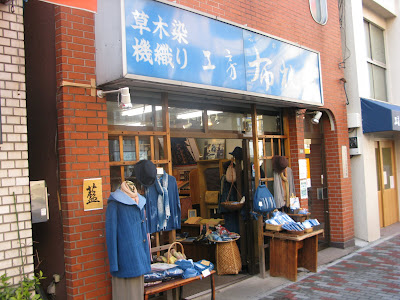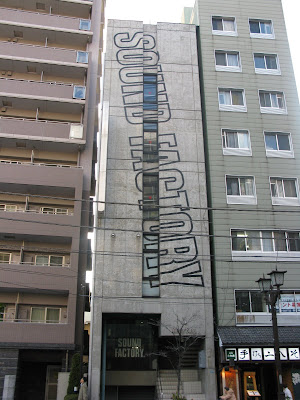
 One stop on from Komagome, and I had no idea what to expect from this area as my small Tokyo atlas had very little detail about the area ~ in fact there seemed to be a blank area near the station.
One stop on from Komagome, and I had no idea what to expect from this area as my small Tokyo atlas had very little detail about the area ~ in fact there seemed to be a blank area near the station. On exiting the north side of the station I was greeted the ubiquitous sound of Andean pipers, usually in groups admittedly, but maybe this was a reflection of how lucrative a busking spot this station is.
On exiting the north side of the station I was greeted the ubiquitous sound of Andean pipers, usually in groups admittedly, but maybe this was a reflection of how lucrative a busking spot this station is. It was a long walk over a bridge over the rail tracks and a large area of railway sidings before the slope down to Tabata-Shinmachi.
It was a long walk over a bridge over the rail tracks and a large area of railway sidings before the slope down to Tabata-Shinmachi. I walked and walked, then walked some more, but the area seemed mainly occupied by apartment blocks and small warehouses, with little of interest to the casual visitor.
I walked and walked, then walked some more, but the area seemed mainly occupied by apartment blocks and small warehouses, with little of interest to the casual visitor. Some railway bridges in Tokyo have interesting murals painted on them, sometimes reflecting something of the area. The one here, together with the 'railway track memorial bench' below, seem to indicate that trains have been a part of the daily life here for some time.
Some railway bridges in Tokyo have interesting murals painted on them, sometimes reflecting something of the area. The one here, together with the 'railway track memorial bench' below, seem to indicate that trains have been a part of the daily life here for some time. A short while later there were a few streets with some shops that seemed to have a bit of character.
A short while later there were a few streets with some shops that seemed to have a bit of character.  The ideal spot for masochists to have a coffee? [OK, scraping the barrel, I know , but I was getting desperate to find anything interesting to snap by this stage]
The ideal spot for masochists to have a coffee? [OK, scraping the barrel, I know , but I was getting desperate to find anything interesting to snap by this stage]
This liquor shop is a throw back to the Showa era, and probably has the same layout as when it first opened.
 All the walking with little to show for it meant I had worked up an appetite, so I popped into a local restaurant for a katsu-don set, which hit the spot.
All the walking with little to show for it meant I had worked up an appetite, so I popped into a local restaurant for a katsu-don set, which hit the spot.
 Over the road from the restaurant was the right place to go to buy a new lawn, or they could conceivably be in the window business given the mix ups you can find.
Over the road from the restaurant was the right place to go to buy a new lawn, or they could conceivably be in the window business given the mix ups you can find. Then it was a hike back over to the other side of the station.
 Tokyo is well-known as a city that makes use of every spare piece of land, but this corrugated iron dwelling is ridiculously narrow.
Tokyo is well-known as a city that makes use of every spare piece of land, but this corrugated iron dwelling is ridiculously narrow.
 A pleasant place to get your hair done.
A pleasant place to get your hair done.
 I don't know what he sells, but I don't imagine there are many other Arnolds trading in Japan.
I don't know what he sells, but I don't imagine there are many other Arnolds trading in Japan.
 After wandering past more and more apartment blocks and building sites (there seemed to a lot of construction going on), I eventually found the Tokaku-ji temple, with its collection of impressive statues.
After wandering past more and more apartment blocks and building sites (there seemed to a lot of construction going on), I eventually found the Tokaku-ji temple, with its collection of impressive statues.
 Tokyo is well-known as a city that makes use of every spare piece of land, but this corrugated iron dwelling is ridiculously narrow.
Tokyo is well-known as a city that makes use of every spare piece of land, but this corrugated iron dwelling is ridiculously narrow. A pleasant place to get your hair done.
A pleasant place to get your hair done. I don't know what he sells, but I don't imagine there are many other Arnolds trading in Japan.
I don't know what he sells, but I don't imagine there are many other Arnolds trading in Japan. After wandering past more and more apartment blocks and building sites (there seemed to a lot of construction going on), I eventually found the Tokaku-ji temple, with its collection of impressive statues.
After wandering past more and more apartment blocks and building sites (there seemed to a lot of construction going on), I eventually found the Tokaku-ji temple, with its collection of impressive statues. 






































